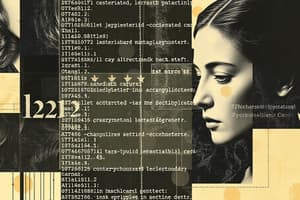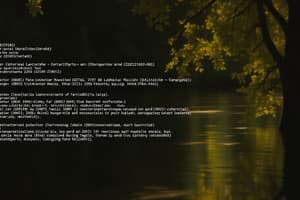Podcast
Questions and Answers
What is an algorithm?
What is an algorithm?
- A graphical representation of a program
- A step-by-step analysis of a process (correct)
- An informal programming language
- A sequence of random instructions
Pseudocode is an informal language that helps programmers develop algorithms.
Pseudocode is an informal language that helps programmers develop algorithms.
True (A)
What are the three types of control structures included in algorithms and flowcharts?
What are the three types of control structures included in algorithms and flowcharts?
Sequence, Branching (Selection), Loop (Repetition)
Which of the following statements about algorithms is true?
Which of the following statements about algorithms is true?
The branching control structure in algorithms typically uses the ______ statement.
The branching control structure in algorithms typically uses the ______ statement.
What does the symbol '=' represent in programming languages?
What does the symbol '=' represent in programming languages?
What is a flowchart primarily used for?
What is a flowchart primarily used for?
An algorithm is a sequence of steps that produces a result and terminates in an infinite time.
An algorithm is a sequence of steps that produces a result and terminates in an infinite time.
What is an algorithm?
What is an algorithm?
What are the three types of control structures in algorithms and flowcharts?
What are the three types of control structures in algorithms and flowcharts?
Which of the following statements is true about pseudocode?
Which of the following statements is true about pseudocode?
An algorithm is dependent on the programming language being used.
An algorithm is dependent on the programming language being used.
What does the loop control structure do in an algorithm?
What does the loop control structure do in an algorithm?
What is a flowchart?
What is a flowchart?
What is the primary use of pseudocode?
What is the primary use of pseudocode?
Which of the following is NOT an advantage of using algorithms?
Which of the following is NOT an advantage of using algorithms?
Match the following terms with their definitions:
Match the following terms with their definitions:
Flashcards are hidden until you start studying
Study Notes
What is a Pseudocode
- Pseudocode is a written description of an algorithm. It doesn't use actual code and is easy to understand.
- It helps programmers develop algorithms because it doesn't follow the rigid rules of a specific programming language.
- It can't be executed on a computer, but it helps programmers design and understand algorithms before coding.
Pseudocode and Flowchart Examples
- Example #1 has a flowchart, but the text doesn't explain it.
- Example #2 is explained below using an algorithm:
Algorithm
- "Algorithm" is based on the name of the mathematician Al-khowarizmi.
- Software engineers use algorithms for planning and solving problems.
- It is a step-by-step method to solve a problem.
- It should be unambiguous and finish in a finite amount of time.
Algorithm Characteristics
- Input: Start with some information, like numbers or data.
- Output: Provide a result after processing the input.
- Definiteness: Each step should be clear and well-defined.
- Finiteness: The algorithm should end after a finite number of steps.
Three Types of Control Structures
- Sequence: Steps are executed one after the other, top to bottom.
- Branching (Selection): Uses a condition (TRUE or FALSE) to decide which path to take in the algorithm. The "IF-THEN " is a common way to represent this.
- Loop (Repetition): Allows a set of steps to be repeated based on a condition. Examples include WHILE and FOR loops.
Advantages of Algorithms
- They make solutions to problems easier to understand.
- They use a clear process.
- They are language-independent, so even people without coding skills can understand them.
- Each step is logically ordered, making debugging easier.
How to Write Algorithms
- Start with input variables for calculations, like HEIGHT and WIDTH for calculating the area of a rectangle.
- Outline the algorithm's operations: These can be multiple steps and branch depending on input.
- Mathematical Operators: Use common operators like +, -, *, /, etc.
- Input/Output: Use keywords like INPUT, READ, GET to input data and PRINT, WRITE, DISPLAY to output results.
How to Use Flowcharts to Represent Algorithms
- Flowcharts are visual representations of algorithms.
- Can be used in various situations: business, education, personal, as well as algorithms.
- They are often used for program planning because they clearly show the flow of a program.
What is a Pseudocode
- Pseudocode is an informal language that programmers use to write algorithms.
- It uses human-readable descriptions of the algorithm using plain language.
- Unlike programming languages, it doesn't have a specific syntax designed to be executed by a computer.
- It uses indentation to indicate dependencies, such as loops, conditional statements, or switching.
Algorithm & Flowchart Examples
What is an Algorithm
- An algorithm is a step-by-step plan for solving a problem.
- It is a sequence of instructions that are unambiguous - meaning the steps are clear and cannot be interpreted in multiple ways.
- Software engineers use algorithms to plan and solve problems in computer programming.
Characteristics of an Algorithm
- It must have a clear starting point and a clear ending point.
- Each instruction should be finite, meaning that it can be completed in a finite amount of time.
- An algorithm should be effective, meaning each step can be carried out in a practical manner.
- It must be unambiguous, meaning each step can be interpreted in only one way.
Control Structures in Algorithm
-
Algorithms can be implemented using three main types of control structures:
Sequence Structure
- Instructions are executed one after the other, from top to bottom, in the order they are written.
Branching (Selection) Structure
- It provides a way to make decisions based on conditions.
- If a condition is evaluated as “TRUE,” one set of instructions is executed, otherwise another set of instructions is executed.
- The “IF-THEN-ELSE” structure is commonly used to represent branching.
Loop (Repetition) Structure
- Allows a set of instructions to be executed repeatedly until a specific condition is met.
- It's used when the same set of instructions needs to be repeated multiple times.
- Examples of loop structures include: “WHILE,” “FOR,” and “DO WHILE."
Advantages of using an Algorithm
- It helps visually understand the process of solving a problem.
- It provides a well-defined procedure for solving the problem.
- It is independent of any specific programming language.
- It is easy to debug because each step has a logical sequence.
How to Write an Algorithm
- Define the problem you want to solve.
- Outline the operations to solve the problem.
- Implement the operations with input and output variables.
- Example: To find the area of a rectangle, multiply the HEIGHT and WIDTH variables and store the result in a new variable called AREA.
- To assign a value to a variable, use the symbol '='.
- For example, HEIGHT = 5.
- The symbol '=' is used as an assignment symbol, similar to most programming languages.
- Mathematical operators:
- The operator '+' is usually used for addition.
- '−' is used for subtraction.
- '*' is used for multiplication.
- '/' is used for division.
- Key words that can be used to represent input: INPUT, READ, or GET.
- Key words that can be used to represent output: PRINT, WRITE, or DISPLAY.
How to Use Flowcharts to Represent Algorithms
- Flowcharts are visual representations of algorithms.
- They use symbols to represent different stages of the algorithm and arrows to show the flow of execution.
- Different types of symbols are used for different actions, such as input/output, processing, decision, and start/end.
- Flowcharts can be used to describe all types of processes, not just algorithms.
- They are often used as a program planning tool to visually show the logical flow of a process.
Studying That Suits You
Use AI to generate personalized quizzes and flashcards to suit your learning preferences.




